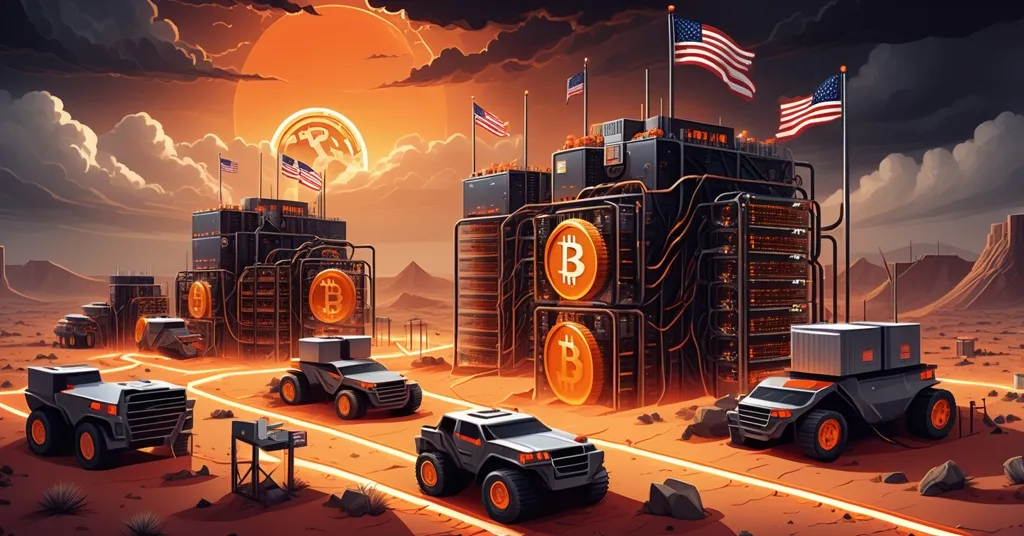Bitmain’s US Factory Launch: A Game-Changer for Bitcoin Mining in 2026

Bitmain’s US Factory Launch: A Pivotal Moment for Bitcoin Mining
Bitmain, the colossus of Bitcoin mining hardware, has announced a groundbreaking move: its first US manufacturing facility, set to start production in early 2026. This isn’t a mere operational tweak—it’s a strategic earthquake that could redefine the global Bitcoin mining landscape amid US-China trade wars and a warming US policy toward crypto.
- Market Titan: Bitmain commands 82% of the ASIC market, overshadowing MicroBT (15%) and Canaan (2%), according to University of Cambridge data.
- US Rollout: Chip production begins early 2026, with full capacity by year-end in either Texas or Florida.
- Driving Forces: Escaping trade tariffs, speeding up US deliveries, and leveraging a crypto-friendly political shift.
Unpacking the Move: Why the US, Why Now?
Bitmain is synonymous with Bitcoin mining power. They produce Application-Specific Integrated Circuits (ASICs)—specialized rigs built solely to mine Bitcoin by crunching complex math problems that secure the network. Their dominance, holding 82% of the global ASIC market, means most of Bitcoin’s hash rate (the total computational power safeguarding the blockchain) relies on their hardware. So, when they decide to set up shop in the US, with Texas or Florida as potential headquarters (decision due by Q3 2025), the entire crypto world takes notice. For deeper insights into their market control, check out this analysis of Bitmain’s ASIC dominance.
The reasoning is multifaceted. Rising US-China trade tensions, coupled with punishing tariffs on tech imports, have made China a risky base. A stark example came in November 2024 when US Customs seized thousands of Bitmain ASICs over alleged links to sanctioned entities like Huawei through a murky intermediary, Xiamen Sophgo. Though the hardware was released by March 2025, the incident exposed the fragility of overseas reliance. Add to that the logistical edge of being closer to a massive US customer base—cutting shipping delays from weeks to days—and the appeal of a more crypto-welcoming US under the Trump administration, and the move looks like a no-brainer. Learn more about the US crypto policy shifts under Trump that are influencing such decisions.
“Initial chip production kicks off in early 2026, with full operational capacity by the end of that year,” stated Irene Gao, Bitmain’s Global Business Executive.
Gao also framed this as a strategic coup, noting,
“American operations will drastically cut product delivery times and turbocharge customer service response times.”
For US miners who’ve lost profits waiting on delayed rigs during market surges, that’s music to the ears. China’s long been the ASIC production hub due to cheap costs and tight supply chains, but geopolitical heat is rewriting the playbook. Bitmain isn’t just relocating; they’re positioning the US as the next frontier for Bitcoin infrastructure. For more on their plans, see Irene Gao’s statements on Bitmain’s US expansion.
The Upside: A Boost for US Crypto and Bitcoin’s Resilience
There’s plenty to cheer about here. Bitmain’s US factory could transform America into a heavyweight in Bitcoin mining infrastructure. North America already claims a growing slice of global hash rate, with Texas alone hosting nearly 20% of US mining due to cheap, often deregulated energy. Local production means faster, cheaper access to hardware for American miners, potentially lowering the entry bar for smaller players who can’t afford import delays. Bitmain also commits to hiring 250 local workers in the first phase, focusing on manufacturing and maintenance with training included. That’s not just payroll—it’s a chance to reframe crypto as a job creator, not a speculative bubble. Explore how Bitcoin mining is driving US infrastructure growth.
If this pays off, competitors like MicroBT or Canaan might jump on the bandwagon, turning the US from a mining fringe into a hardware epicenter. For Bitcoin maximalists, this geographic spread is a win; it bolsters the network’s resilience against regional disruptions like China’s past mining bans. Plus, local investment could sway public and political sentiment, nudging policies toward supporting crypto rather than stifling it. Imagine a future where Bitcoin isn’t just a digital asset but a recognized economic driver—Bitmain’s move plants a seed for that. Get a broader perspective on their strategy via why the Bitcoin community should take note of Bitmain’s US plans.
The Dark Side: Centralization Woes and Other Pitfalls
Before we get too cozy with optimism, let’s rip the Band-Aid off. Bitmain’s 82% chokehold on the ASIC market is a glaring violation of Bitcoin’s decentralization ethos. One company controlling the majority of mining hardware is a single point of failure begging to be exploited. What if Bitmain gets hacked, strong-armed by a government, or embeds shady firmware? Past murmurs, like the 2017 AntBleed fiasco where their rigs allegedly had remote shutdown capabilities, fuel paranoia. A US factory spreads geographic risk but doesn’t dent the core issue: too much power in one player’s hands. Without serious competition or open-source ASIC alternatives, we’re stuck bowing to a crypto overlord with a new address. For background on their hardware, refer to the Bitmain Bitcoin hardware overview.
Environmental blowback is another beast. Texas, a leading candidate for the factory, is already a battleground over crypto mining’s energy hunger. During 2022 heatwaves, miners like Riot Blockchain paused operations amid grid strain and public outcry. If Bitmain ramps up without a rock-solid green strategy—think direct renewable contracts or carbon offsets—locals will roar louder than a busted ASIC fan. Florida’s no safe haven either, with hurricane-prone grids and growing scrutiny on power hogs. Bitmain’s mum on sustainability plans, and that silence could bite hard.
Then there’s the regulatory wildcard. The Trump administration might be crypto’s cheerleader today, but US policy turns on a dime. The SEC’s history of sucker punches and state-level meddling—like New York’s mining moratoriums—means Bitmain could hit unforeseen walls. What if a future regime tags large-scale mining as a “security threat” or slaps domestic tariffs? Geopolitical risks don’t disappear; they just swap jerseys. Dive into community discussions on Bitmain’s US factory impact on mining for varied perspectives.
Devil’s Advocate: Are We Overhyping This?
Let’s flip the script and ask the ugly questions. Even if Bitmain’s US hub runs like clockwork, does it really move the needle? Centralization aside, a new factory might just trade old headaches for shiny new ones. Fast forward a decade—if regional tensions spike in North America or fresh trade barriers emerge, we’re dodging the same bullets. And don’t expect Bitmain’s relocation to spawn a magical wave of competitors. ASIC production is a brutal game with sky-high R&D costs and specialized manufacturing barriers. Without policy muscle or grassroots innovation, hardware decentralization is pure fantasy. Curious about their hardware value? Check out opinions on whether Bitmain’s rigs are worth the investment.
What about altcoin miners? Bitmain’s laser focus on Bitcoin ASICs could leave Ethereum (post-merge GPU setups), Litecoin, or smaller chains out in the cold. While we lean Bitcoin maxi here, we can’t ignore that altcoins plug holes BTC doesn’t—like smart contracts or dirt-cheap transactions. Neglecting their hardware needs might skew the ecosystem further toward Bitcoin, stifling the wider decentralized revolution we champion.
And to the hype merchants swearing this guarantees Bitcoin’s price will soar or adoption will explode—get a grip. Hardware shifts don’t pump markets; sentiment and macro trends do. Adoption rides on usability and trust, not factory pins. We’re not here to peddle fairy tales; we’re slicing through the BS to deliver raw truth. This is a puzzle piece, not the whole damn picture.
Broader Ripples: Competitors, Energy, and Public Perception
Zooming out, Bitmain’s pivot could spark a hardware showdown. MicroBT, with a solid 15% market share, has been snapping at Bitmain’s heels with aggressive pricing. If Bitmain’s US costs swell—higher labor rates than China, anyone?—MicroBT could pounce, either undercutting globally or doubling down in Asia. Canaan, though a smaller fish, has teased US partnerships; Bitmain’s move might light a fire under them. A hardware race on American turf? That’s a spicy subplot. For more context on the trade dynamics, see Bitmain’s 2026 US factory plans amid trade tensions.
Energy debates can’t be sidestepped. Texas’s deregulated grid dangles cheap power—sometimes near-zero during surpluses—but it’s a gamble. Price spikes and outages, like the 2021 winter storm, expose vulnerabilities. Florida’s natural gas reliance and hurricane risks add their own chaos. Bitmain needs bulletproof backups or renewable deals to dodge a PR nightmare. Without transparency, they’re begging for a backlash that could taint crypto’s image further.
Culturally, there’s potential gold. Hiring 250 Americans isn’t just stats—it’s a narrative shift. Training locals in cutting-edge tech could flip crypto from “planet-killer” to “career-builder.” But screw up with energy scandals or labor gripes, and it’s ammo for anti-crypto zealots. Bitmain’s walking a tightrope, and the stakes for public perception are sky-high.
Key Questions and Takeaways on Bitmain’s US Gamble
- Why is Bitmain planting roots in the US?
To evade US-China trade tariffs, bypass customs nightmares like the 2024 ASIC seizures, and slash delivery times for US miners while tapping a crypto-friendly policy wave. - Could this redefine global Bitcoin mining?
Absolutely—it might make the US a hardware hub, boosting local hash rate and possibly drawing competitors like MicroBT, diversifying production away from China. - What’s the catch with Bitmain’s market control?
Their 82% ASIC dominance is a decentralization red flag; a US factory doesn’t fix the risk of one company holding the network’s security keys if compromised. - Will environmental pushback derail this?
Damn likely. Huge energy demands in Texas or Florida could ignite fierce opposition unless Bitmain prioritizes renewables—their silence here screams trouble. - Does this fuel US Bitcoin adoption?
It’s possible. Local jobs and investment might soften public and political stances on crypto, but only if energy or regulatory disasters don’t steal the spotlight. - Are altcoin miners left behind?
Probably. Bitmain’s Bitcoin focus might ignore altcoin hardware needs, tilting the US ecosystem toward BTC and sidelining other chains’ innovation. - Is this a surefire win for Bitcoin’s price or future?
Hell no. Hardware logistics don’t drive market pumps or adoption alone—sentiment, usability, and trust weigh heavier. Don’t buy the overhyped nonsense.
Bitmain’s US factory is a gutsy play in the grand chess match of Bitcoin’s trajectory. It’s a defiant stand against geopolitical traps, a potential rocket boost for American mining, and a loud signal of crypto’s grit. Yet, it’s haunted by centralization ghosts, environmental firestorms, and regulatory unpredictability. Every silver lining has a storm cloud—will this fortify Bitcoin’s decentralized soul, or just redraw the battle lines of vulnerability? As 2026 looms, one thing’s certain: this isn’t just about cranking out chips. It’s about the foundation of the financial rebellion we’re all-in on. Stay sharp—this ride’s just revving up.



